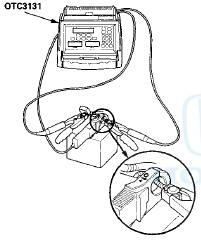 Honda Accord: Alternator and Regulator
Circuit Troubleshooting
Honda Accord: Alternator and Regulator
Circuit Troubleshooting
Special Tools Required
Alternator, Regulator, Battery, and Starter Tester OTC3131* ^Available through the Honda Tool and Equipment Program 888-424-6857
1. Make sure the battery connections are good and the battery is sufficiently charged.
2. Connect the alternator, regulator, battery & starter tester (OTC3131) to the battery as shown.
NOTE: The probe is used for alternator testing.

3. Start the engine. Hold the engine speed at 3,000 rpm with no load (in N or P (A/T model) or neutral (M/T model)) until the radiator fan comes on, then let it idle.
4. Do the CHARGING SYSTEM TEST.
Does the display indicate voltage within 13.5-”15.1 V and amperage of 87.5 A or more? YES-Go to step 5.
NO-lf the voltage is less than 13.5 V, go to alternator control circuit troubleshooting (see page 4-28). If the voltage is over 15.1 V and amperage is less than 87.5 A, replace the alternator (see page 4-32) or repair the alternator (see page 4-34).
5. Check the diode condition on the display.
Does the display indicate GOOD? YES-The diode is OK. Troubleshooting is complete.ll NO-lf the display indicates BAD, replace the alternator (see page 4-32) or repair the alternator (see page 4-34), then retest.B NOTE If the display indicates N/A, the diode pattern could not be diagnosed. Repeat the test. If N/A appears repeatedly, replace the alternator.
 Charging System Indicator
Circuit Troubleshooting
Charging System Indicator
Circuit Troubleshooting
troubleshooting the charging system indicator.
1. Turn the ignition switch to ON (II).
Does the charging system indicator come on?
YES-Go to step 2.
NO-Go to step 14.
2. Start the engine. ...
 Alternator Control Circuit
Troubleshooting
Alternator Control Circuit
Troubleshooting
NOTE: Do this troubleshooting if, in step 5 of the
alternator and regulator circuit troubleshooting (see
page 4-27), the battery voltage is less than 13.5 V.
* 1. Connect the Honda Diagnostic Sys ...
See also:
Modifying Your Vehicle
Removing parts from your vehicle,
or replacing components with
non-Honda components could
seriously affect your vehicle’s
handling, stability, and reliability.
Some examples are:
Lowering ...
Motor Test
1. Remove the front seat back panel, and seat-back
cover/pad.
• 4-door (see page 20-221)
• 2-door (see page 20-213)
2. Disconnect the 2P connector (A) from the lumbar
support motor (B ...
Crankshaft and Piston Remowal
1 Remove the engine/transmission (see page 5-3).
2. Remove the transmission:
- Manual transmission (see page 13-7)
m Automatic transmission (see page 14-194)
3. M/T model: Remove the flywheel (s ...
